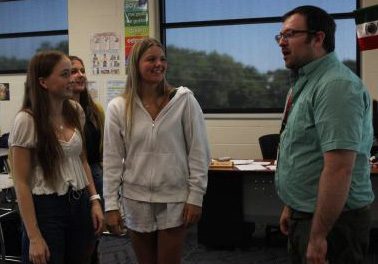Spanish Department Devoted to Get Things Back on Track After A Rocky Last Year

Sep 16, 2022
Last school year the Spanish department struggled with teachers departing and wavering curriculums. The department is coming back with a strategy to solve it all, with new teachers, such as Christopher Eitzen and Brooke Wardle.
“As some people will remember, last year we lost almost every Spanish teacher and because of that there was a lot of inconsistency between what students were learning,” Cameron Hale, the new department chair for world languages, said.
With the loss of more than half of the Spanish department due to a variety of reasonings, Linda Stringer, one of the remaining Spanish teachers had a much bigger workload than normal.
“I was teaching Spanish 1, and then I was giving additional classes, and then I had to teach classes that I didn’t even see my students, so I had a full schedule of ten classes,” Stringer said. “They got a sub because the current sub that was in those classes did not speak much Spanish. So the kids felt really lost and they were struggling and it was hard to keep up with work.”
In the middle of the second semester, a new substitute teacher was brought in who was able to better communicate the language to the students, helping to later lower the workload.
“I got rid of like two upper-level classes and I stayed with one of my upper-level classes. I still had a bit of [a larger] load than normal but it was much better,” Stringer said.
In the upper-level classes, the effects of years prior are more easily seen. While the struggles from last year did not help matters, it is not the only reason. Not only were there inconsistencies due to staff changes that affected the curriculum last year, but there have also been COVID struggles in the years before.
“I feel like a lot of my students are behind where they should be and not just because of last year, also because of the years prior,” Eitzen said. “Like COVID didn’t help, teaching remotely, taking those classes remotely. So hopefully in the next year or two, I can fix that I think, a lot of reteaching things that they should already know. Eventually, we will move past that and have a good program going forward.”
There have been many struggles in the previous school years. Unlike other years, however, this year there is a plan set in place to prevent that from happening. One of the key parts of this plan is a new, more unified curriculum.
“So we are working through a curriculum together that is definitely a lot more unified than what I’m used to,” Wardle said. “It’s a really neat program; not only does it explore the language through culture but it also allows for that story input which is really a unique piece. It’s something that allows for people to interpret the language on a new level which is really neat.”
This curriculum will not only be focused on culture and stories. It will also heavily focus on the understanding of the language; one of the major goals of foreign language classes.
“We are using a curriculum that instead of focusing just on maybe grammar, for example, it focuses a lot on reading and listening as well as speaking and writing…So that teachers are actually speaking Spanish in the classroom and it is much more unified,” Hale said.
With this new curriculum, the students will all be learning the same things, no matter who their teacher is. A major part of this new curriculum is the Comprehensible Input Method. This method means that teachers are going farther than teaching about simple things such as vocabulary and grammar. While those are important, the new method will be able to provide the ability to apply knowledge in the real world.
“There’s a bunch of research on comprehensible input that states that with that type of learning method whatever we as teachers output is the overall input the students get,” Wardle said. “Even if they’re not necessarily feeling like they’re at a place to speak it, write it, or read it right away. It’s eventually a goal that will solidify their knowledge of the language over time.”
As a part of the new unified curriculum, teachers have been in a lot of collaboration with each other. This way everyone is teaching the same things and all students are receiving the same content.
“We have made the design of we are going to collaborate effectively to have a more cohesive plan so we’re always on the same page, always discussing the topics we are teaching, always reporting feedback of how we feel that topic was taught and what we can improve on,” Wardle said.
While the teachers teaching the same content collaborate more often, all the Spanish teachers frequently meet and discuss how things are going.
“I am kind of telling them what I want them to know for the upper-level classes. For instance, ‘Make sure you teach this in Spanish 1 and make sure you have this in Spanish 2,’” Eitzen said. “And if you have the same content as someone else we collaborate so we have the same, you know, content. So everyone has the same system so that way [the students] know what they are supposed to know by the time they get to Spanish 3 and 4.”
Due to all these changes, this year’s Spanish department is said to hopefully go much more smoothly than in years past.
“Things are going good, that we can rely on each other because this is a new program that we are doing. It’s a different method of teaching the language so that might be a little bit of an adjustment and then just seeing how the students progress it,” Stringer said.





